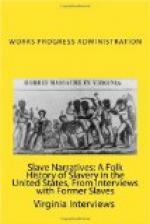“Along about time for de surrender, Col. Jesse, our master, took sick and died with some kind of head trouble. Then Col. Bob, our young master, took care of his mama and the slaves. All the grown folks went to the field to work and the little chillun would be left at a big room called the nursing home. All us little ones would be nursed and fed by an old mammy, Aunt Mandy. She was too old to go to the field, you know. We wouldn’t see our mammy and daddy from early in the morning till night when their work was done, then they’d go by Aunt Mandy’s and get their chillun and go home till work time in the morning.
“Some of the slaves were house negroes. They didn’t go to work in the fields, they each one had their own job around the house, barn, orchard, milk house, and things like that.
“When washday come, Lord, the pretty white clothes! It would take three or four women a washing all day.
“When two of de slaves wanted to get married, they’d dress up nice as they could and go up to the big house and the master would marry them. They’d stand up before him and he’d read out of a book called the ‘discipline’ and say, ’Thou shalt love the Lord thy God with all thy heart, all thy strength, with all thy might and thy neighbor as thyself.’ Then he’d say they were man and wife and tell them to live right and be honest and kind to each other. All the slaves would be there too, seeing the ‘wedden’.
“Our Miss Sallie was the sweetest best thing in the world! She was so good and kind to everybody and she loved her slaves, too. I can remember when Uncle Tony died how she cried! Uncle Tony Wadd was Miss Sallie’s favorite servant. He stayed in a little house in the yard and made fires for her, brought in wood and water and just waited on the house. He was a little black man and white-headed as cotton, when he died. Miss Sallie told the niggers when they come to take him to the grave yard, to let her know when they got him in his coffin, and when they sent and told her she come out with all the little white chillun, her little grandchillun, to see Uncle Tony. She just cried and stood for a long time looking at him, then she said, ’Tony, you have been a good and faithful servant.’ Then the Negro men walked and carried him to the graveyard out in a big grove in de field. Every plantation had its own graveyard and buried its own folks, and slaves right on the place.




